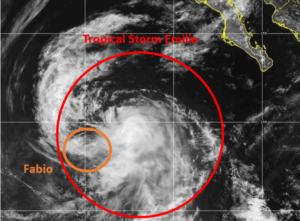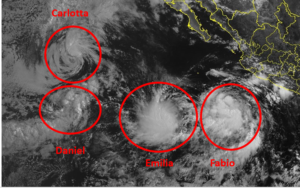The circulations around Tropical Storms Emilia and Fabio were interacting on Tuesday afternoon.
At 5:00 p.m. EDT on Tuesday the center of Tropical Storm Emilia was located at latitude 14.4°N and longitude 115.3°W which put the center about 685 miles (1110 km) south-southwest of the southern tip of Baja California. Emilia was moving toward the northwest at 3 m.p.h. (5 km/h). The maximum sustained wind speed was 65 m.p.h. (105 km/h) and there were wind gusts to 80 m.p.h. (130 km/h). The minimum surface pressure was 992 mb.
At 5:00 p.m. EDT on Tuesday the center of Tropical Storm Fabio was located at latitude 19.2°N and longitude 113.9°W which put the center about 625 miles (1010 km) west of Manzanillo, Mexico. Fabio was moving toward the west-northwest at 21 m.p.h. (33 km/h). The maximum sustained wind speed was 60 m.p.h. (95 km/h) and there were wind gusts to 75 m.p.h. (120 km/h). The minimum surface pressure was 997 mb.
The circulations around Tropical Storm Emilia and Fabio were interacting on Tuesday afternoon. Winds blowing around the southern side of Fabio’s circulation were interacting with winds that were blowing around the northern side of Tropical Storm Emilia. The interactions were occurring in both the upper and lower troposphere. The interactions were affecting the structures of both tropical storms.
Tropical Storm Emilia appeared to be the larger and more powerful of the two tropical storms. Even so, the flow around the southern side of Fabio was having an effect on Emilia’s structure. Most of the thunderstorms in Tropical Storm Emilia were occurring in bands in the southern half of Emilia’s circulation. Bands in the northern side of Emilia consisted primarily of showers and low clouds. Outflow from Tropical Storm Fabio was inhibiting upper level divergence to the north of Tropical Storm Emilia.
The interactions between the two tropical storms was also affecting the distribution of wind speeds in Tropical Storm Emilia. Winds to tropical storm force extended out 140 miles (220 km) in the southern half of Emilia’s circulation. Winds to tropical storm force only extended out 70 miles (110 km) in the northern side of Emilia.
The interaction with Tropical Storm Emilia appeared to be contributing to the start of a weakening trend in Tropical Storm Fabio. The interaction with Emilia was also affecting the structure of Tropical Storm Fabio. Most of the thunderstorms were occurring in bands in the eastern side of Fabio’s circulation. Bands in the western part of Tropical Storm Fabio consisted primarily of showers and lower clouds. Outflow from Tropical Storm Emilia was inhibiting upper level divergence to the south and west of Tropical Storm Fabio,
The interactions between the two tropical storms was also affecting the distribution of wind speeds in Tropical Storm Fabio. Winds to tropical storm force extended out 100 miles (160 km) in the eastern side of Fabio’s circulation. Winds to tropical storm force only extended out 35 miles (55 km) in the eastern half of Fabio.
It is possible that the larger circulation around Tropical Storm Emilia could absorb the smaller circulation of Tropical Storm Fabio. The circulation around Fabio will continue to disrupt part of the circulation in the northern part of Tropical Storm Emilia. Emilia may not intensify much during the interactions between the two storms.
Tropical Storm Emilia will move through an environment that is otherwise favorable for intensification during the next 24 hours. Emilia will move move over water where the Sea Surface Temperatures are near 28°C. It will move under an axis of an upper level ridge over the Eastern North Pacific Ocean. The upper level winds are weak near the axis of the ridge. There will be little vertical wind shear except for the shear caused by the outflow from Tropical Storm Fabio. Tropical Storm Emilia is likely to intensify during the next 24 hours. Emilia could strengthen to a hurricane.
Tropical Storm Emilia will move around the southern side of a high pressure system over the Eastern North Pacific Ocean. The interaction with Tropical Storm Fabio is likely to pull Emilia toward the northwest during the next 24 hours. On its anticipated track, Tropical Storm Emilia will move farther away from Baja California. Emilia is likely to be steered toward the west-northwest by the high pressure system after it absorbs Tropical Storm Fabio.


